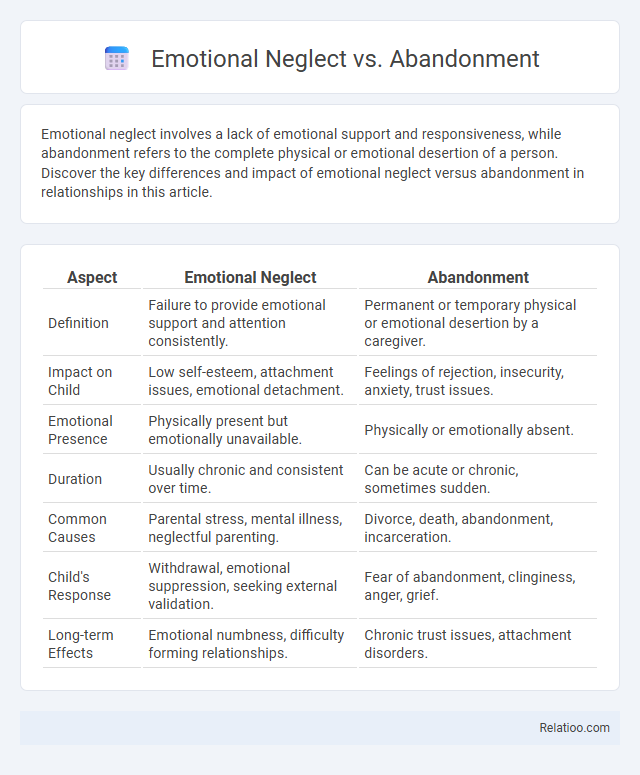Emotional neglect involves a lack of emotional support and responsiveness, while abandonment refers to the complete physical or emotional desertion of a person. Discover the key differences and impact of emotional neglect versus abandonment in relationships in this article.
Table of Comparison
| Aspect | Emotional Neglect | Abandonment |
|---|---|---|
| Definition | Failure to provide emotional support and attention consistently. | Permanent or temporary physical or emotional desertion by a caregiver. |
| Impact on Child | Low self-esteem, attachment issues, emotional detachment. | Feelings of rejection, insecurity, anxiety, trust issues. |
| Emotional Presence | Physically present but emotionally unavailable. | Physically or emotionally absent. |
| Duration | Usually chronic and consistent over time. | Can be acute or chronic, sometimes sudden. |
| Common Causes | Parental stress, mental illness, neglectful parenting. | Divorce, death, abandonment, incarceration. |
| Child's Response | Withdrawal, emotional suppression, seeking external validation. | Fear of abandonment, clinginess, anger, grief. |
| Long-term Effects | Emotional numbness, difficulty forming relationships. | Chronic trust issues, attachment disorders. |
Understanding Emotional Neglect: Definition and Signs
Emotional neglect involves a caregiver's failure to provide necessary emotional support, leading to feelings of invisibility and unworthiness in the individual. Unlike abandonment, which is a physical or emotional withdrawal, emotional neglect is characterized by ongoing disregard for the person's emotional needs. Common signs include difficulty identifying emotions, low self-esteem, and challenges forming healthy relationships.
What Is Emotional Abandonment? Key Differences
Emotional abandonment occurs when a caregiver is physically present but fails to provide emotional support or attention, leaving the individual feeling isolated and unloved. Unlike emotional neglect, which involves a consistent lack of emotional responsiveness, abandonment implies a sudden or complete withdrawal of emotional availability. The key difference lies in the intentional or perceived absence of emotional connection in abandonment versus the ongoing emotional unavailability in neglect.
Core Causes Behind Emotional Neglect and Abandonment
Emotional neglect stems primarily from caregivers' consistent failure to meet a child's emotional needs, often due to their own unresolved issues or lack of emotional awareness. Abandonment involves physical or emotional absence, where a caregiver is unavailable or unreliable, leading to feelings of insecurity and mistrust. Both experiences deeply affect attachment patterns, with neglect rooted in omission of care and abandonment arising from absence or rejection, impacting long-term emotional development.
Developmental Impact on Children and Adolescents
Emotional neglect deprives children and adolescents of essential emotional support, leading to impaired self-esteem, difficulty in forming secure attachments, and increased risk of anxiety and depression. Abandonment, characterized by the physical or emotional withdrawal of a caregiver, often results in profound feelings of insecurity, trust issues, and developmental delays in emotional regulation. Both forms of neglect severely disrupt healthy brain development and social functioning, but abandonment typically triggers more acute trauma responses due to the sudden absence of protective figures.
Emotional Neglect in Adult Relationships
Emotional neglect in adult relationships involves the consistent failure to respond to a partner's emotional needs, leading to feelings of invisibility and loneliness. Unlike abandonment, which is a sudden or permanent withdrawal of support or presence, emotional neglect is a passive form of rejection where emotional needs are ignored or minimized over time. Understanding the impact of emotional neglect is crucial for fostering secure attachment and healthy communication between partners.
Long-Term Psychological Consequences
Emotional neglect involves the consistent failure to provide emotional support, leading to chronic feelings of unworthiness and difficulty forming secure attachments, often resulting in anxiety and depression. Abandonment, whether physical or emotional, typically triggers deep-seated fears of rejection and intense issues with trust, potentially causing attachment disorders and long-term emotional instability. Both forms of neglect and abandonment contribute to complex trauma, significantly impairing emotional regulation and interpersonal relationships in adulthood.
Recognizing Patterns and Red Flags
Emotional neglect often manifests as a consistent lack of attention to an individual's emotional needs, resulting in feelings of invisibility and low self-worth. Abandonment is identified by sudden or prolonged absence, both physical and emotional, leading to deep insecurity and trust issues. Recognizing red flags in these patterns includes withdrawal, difficulty expressing emotions, fear of rejection, and chronic loneliness, which signal underlying emotional harm.
Healing from Emotional Neglect vs. Abandonment
Healing from emotional neglect involves recognizing unmet emotional needs and developing self-compassion to rebuild internal validation, while recovery from abandonment centers on addressing deep-seated fears of rejection and cultivating secure attachments. Therapeutic approaches such as trauma-informed counseling, cognitive-behavioral therapy, and mindfulness techniques play crucial roles in mending the psychological wounds caused by both emotional neglect and abandonment. Establishing healthy boundaries and fostering supportive relationships are essential steps to restore emotional resilience and promote long-term well-being after experiences of emotional neglect or abandonment.
Seeking Support: Therapy and Recovery Resources
Seeking support through therapy is essential for healing from emotional neglect, abandonment, and other forms of emotional trauma, as it provides a safe environment to process feelings and rebuild self-worth. Specialized recovery resources, such as trauma-informed counselors and support groups, offer tailored strategies to address the unique challenges of each experience. Engaging with evidence-based treatments like cognitive-behavioral therapy (CBT) or eye movement desensitization and reprocessing (EMDR) enhances emotional regulation and promotes lasting recovery.
Building Healthy Emotional Connections
Emotional neglect involves the consistent failure to respond to your emotional needs, leaving you feeling unseen and unsupported, while abandonment denotes a physical or emotional withdrawal that disrupts secure attachments. Building healthy emotional connections requires recognizing these patterns and fostering open communication, trust, and empathy to repair or develop strong relational bonds. Addressing emotional neglect and abandonment through therapeutic intervention or self-awareness techniques enhances your ability to form secure, nurturing relationships.

Infographic: Emotional Neglect vs Abandonment
 relatioo.com
relatioo.com